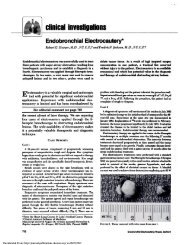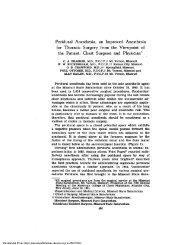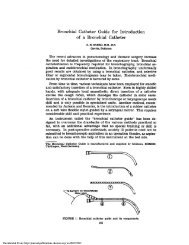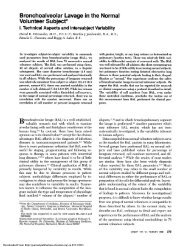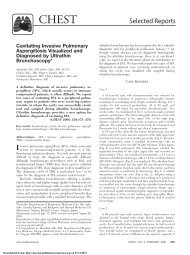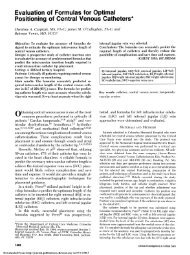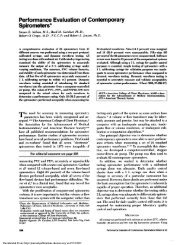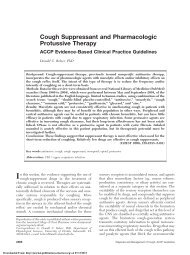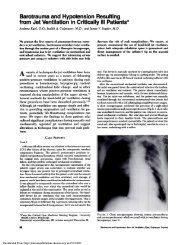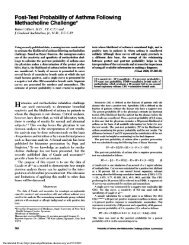Training in Laser Bronchoscopy and Proposals for Credentialling*
Training in Laser Bronchoscopy and Proposals for Credentialling*
Training in Laser Bronchoscopy and Proposals for Credentialling*
You also want an ePaper? Increase the reach of your titles
YUMPU automatically turns print PDFs into web optimized ePapers that Google loves.
<strong>Tra<strong>in</strong><strong>in</strong>g</strong> <strong>in</strong> <strong>Laser</strong> <strong>Bronchoscopy</strong> <strong>and</strong> <strong>Proposals</strong> <strong>for</strong><br />
Credentiall<strong>in</strong>g*<br />
PaulA. Kvale, M.D., F.C.C.P<br />
S urgical techniques are usually learned dur<strong>in</strong>g the<br />
course ofa <strong>for</strong>mal residency or fellowship program<br />
<strong>in</strong> a particular discipl<strong>in</strong>e . However, from time-to-<br />
time, a new technique is devised which is of significant<br />
<strong>in</strong>terest to physicians who have already completed<br />
their <strong>for</strong>mal tra<strong>in</strong><strong>in</strong>g, <strong>and</strong> of potential benefit to a<br />
number of patients, that the technique “catches on”<br />
<strong>and</strong> is applied <strong>in</strong> daily practice. Such a phenomenon<br />
occurred <strong>in</strong> the late 1960s <strong>and</strong> early 1970s after the<br />
pioneer<strong>in</strong>g work of the Japanese to <strong>in</strong>vent fiberoptic<br />
bronchoscopes. Be<strong>for</strong>e that, rigid bronchoscopy was<br />
largely with<strong>in</strong> the doma<strong>in</strong> of thoracic surgeons, oto-<br />
rh<strong>in</strong>olaryngologists, <strong>and</strong> a few bronchoesophagolo-<br />
gists. Then, after fiheroptic bronchoscopes became<br />
available, large numbers ofpulmonary physicians <strong>and</strong><br />
other specialists expressed a desire to learn how to<br />
use this new <strong>in</strong>strument. The problem arose as to how<br />
they might best learn.<br />
For physicians who were <strong>in</strong> their pulmonary fellow-<br />
ships <strong>in</strong> those years, it was a simple matter of learn<strong>in</strong>g<br />
from their mentors. As time has passed, fiheroptic<br />
bronchoscopy has become an <strong>in</strong>tegral part of every<br />
tra<strong>in</strong><strong>in</strong>g program <strong>in</strong> pulmonary diseases. In fact, some<br />
programs <strong>in</strong> thoracic surgery <strong>and</strong> otorh<strong>in</strong>olaryngology<br />
now have difficulty <strong>in</strong> meet<strong>in</strong>g adequate caseloads of<br />
bronchoscopic procedures to tra<strong>in</strong> their residents <strong>and</strong><br />
assure competency. Of special concern is whether<br />
enough physicians (regardless of their specialty) will<br />
be tra<strong>in</strong>ed <strong>in</strong> the use of a rigid bronchoscope <strong>for</strong> those<br />
situations which require its use rather than a flexible<br />
bronchoscope.<br />
A similar situation exists at the present time as it<br />
perta<strong>in</strong>s to tra<strong>in</strong><strong>in</strong>g <strong>in</strong> laser bronchoscopy. The meth-<br />
ods of deal<strong>in</strong>g with the dem<strong>and</strong> <strong>for</strong> tra<strong>in</strong><strong>in</strong>g are very<br />
much like what was observed <strong>for</strong> fiberoptic bronchos-<br />
copy; physicians have a desire to learn a new technique<br />
after they have already completed <strong>for</strong>mal tra<strong>in</strong><strong>in</strong>g <strong>in</strong> a<br />
residency or fellowship program. Gradually, this will<br />
become a “non-issue,” as laser bronchoscopy becomes<br />
an <strong>in</strong>tegral part ofmany (but probably not all) approved<br />
*Fmm the Division of Pulmonary <strong>and</strong> Critical Care Medic<strong>in</strong>e,<br />
Henry Ford Hospital, Detroit.<br />
Repr<strong>in</strong>t requests: 1k Kvde, Mmonary <strong>and</strong> Critical Care Medic<strong>in</strong>e,<br />
Henry Ford Hospital, Detroit 48202<br />
Downloaded From: http://journal.publications.chestnet.org/ on 07/13/2013<br />
residencies <strong>in</strong> pulmonary diseases, thoracic surgery,<br />
<strong>and</strong> otorh<strong>in</strong>olaryngology. When consider<strong>in</strong>g the issue<br />
of tra<strong>in</strong><strong>in</strong>g <strong>in</strong> laser bronchoscopy, it may help to see<br />
how physicians who had already completed their<br />
<strong>for</strong>mal tra<strong>in</strong><strong>in</strong>g years dealt with their needs/desires to<br />
learn how to use the fiberoptic bronchoscope.<br />
One way was to attend a cont<strong>in</strong>u<strong>in</strong>g medical edu-<br />
cation course with laboratory time <strong>for</strong> “h<strong>and</strong>s-on”<br />
experience. Such courses would typically <strong>in</strong>clude<br />
didactic sessions to teach theory <strong>in</strong>dications <strong>and</strong><br />
contra<strong>in</strong>dications, anesthetic <strong>and</strong> operative tech-<br />
niques, specimen preparation <strong>and</strong> process<strong>in</strong>g, man-<br />
agement of complications, postoperative care, <strong>and</strong> a<br />
whole host of other <strong>in</strong><strong>for</strong>mation <strong>in</strong> a short (two to<br />
three day) course.<br />
Some physicians who had already completed <strong>for</strong>mal<br />
tra<strong>in</strong><strong>in</strong>g would make arrangements with faculty mem-<br />
hers at teach<strong>in</strong>g <strong>in</strong>stitutions to learn fiberoptic bron-<br />
choscopy <strong>in</strong> a preceptor type of fashion. Because the<br />
dem<strong>and</strong> was so great with<strong>in</strong> its membership, the<br />
American College of Chest Physicians, through its<br />
Section on Broncholog solicited such arrangements<br />
from recognized authorities with<strong>in</strong> the field of pulmonary<br />
medic<strong>in</strong>e <strong>for</strong> preceptor tra<strong>in</strong><strong>in</strong>g. Henry Ford<br />
Hospital was one such place where preceptor tra<strong>in</strong><strong>in</strong>g<br />
<strong>in</strong> fiberoptic bronchoscopy was available, <strong>and</strong> over a<br />
course ofthree to five years, a few pulmonologists who<br />
had already completed their <strong>for</strong>mal tra<strong>in</strong><strong>in</strong>g years<br />
came here to learn fiberoptic bronchoscopy.<br />
There were several problems <strong>in</strong> try<strong>in</strong>g to conduct<br />
such tra<strong>in</strong><strong>in</strong>g. First, practic<strong>in</strong>g pulmonary physicians<br />
tend to be a busy lot, <strong>and</strong> the dem<strong>and</strong>s ofother patient<br />
care issues often made it difficult to come to the<br />
teach<strong>in</strong>g hospital on a regularly scheduled basis, even<br />
when the teach<strong>in</strong>g <strong>in</strong>stitution was located <strong>in</strong> the same<br />
metropolitan area. Second, patients who required<br />
bronchoscopy at the teach<strong>in</strong>g <strong>in</strong>stitution would be<br />
identified <strong>in</strong> variable numbers <strong>for</strong> a given day, which<br />
made it difficult <strong>for</strong> the practic<strong>in</strong>g physician to know<br />
when adequate caseloads wouldjustify time away from<br />
the practice to acquire the desired tra<strong>in</strong><strong>in</strong>g <strong>and</strong><br />
experience. Third, fellows <strong>in</strong> the tra<strong>in</strong><strong>in</strong>g program at<br />
the teach<strong>in</strong>g <strong>in</strong>stitution greeted such “outsiders” with<br />
CHEST I 97 I 4 I APRIL, 1990 983
less than a warm welcome <strong>for</strong> per<strong>for</strong>m<strong>in</strong>g the bron-<br />
choscopies under the tutelage of the faculty, as such<br />
arrangements would necessarily reduce their case-<br />
loads <strong>for</strong> similar tra<strong>in</strong><strong>in</strong>g <strong>and</strong> experience. There were<br />
two other problems with such arrangements. In some<br />
<strong>in</strong>stitutions (<strong>and</strong> this is even more ofa problem today),<br />
the medical bylaws <strong>and</strong> concerns regard<strong>in</strong>g liability<br />
issues are such that an arrangement of this sort would<br />
not allow the preceptor any “h<strong>and</strong>s-on” experience.<br />
The tra<strong>in</strong>ee could only function as an observer. By<br />
tra<strong>in</strong><strong>in</strong>g <strong>in</strong> a non<strong>for</strong>mal way such as this, there is<br />
always the potential that the tra<strong>in</strong>ee may not become<br />
sufficiently adept at the procedure so as to assure<br />
optimal per<strong>for</strong>mance <strong>and</strong> application <strong>in</strong> practice, <strong>and</strong><br />
the review mechanisms to correct any such deficien-<br />
cies are much less effective than is possible <strong>in</strong> a<br />
structured residency tra<strong>in</strong><strong>in</strong>g program.<br />
Similar phenomena are tak<strong>in</strong>g place now with regard<br />
to tra<strong>in</strong><strong>in</strong>g <strong>in</strong> laser bronchoscopy. At present, few<br />
physicians have been tra<strong>in</strong>ed as a natural part of their<br />
residency/fellowship programs, so the majority of<br />
physicians who wish to become <strong>in</strong>volved <strong>in</strong> per<strong>for</strong>m<strong>in</strong>g<br />
laser bronchoscopy must beg<strong>in</strong> by attend<strong>in</strong>g a laser<br />
bronchoscopy course. Be<strong>for</strong>e attend<strong>in</strong>g a laser bron-<br />
choscopy tra<strong>in</strong><strong>in</strong>g course, it is well to consider what<br />
the anticipated volume of laser bronchoscopy might<br />
be, <strong>and</strong> how the equipment will be funded <strong>and</strong><br />
amortized. All laser equipment is expensive, <strong>and</strong> a<br />
system of shar<strong>in</strong>g the equipment with physicians <strong>and</strong><br />
surgeons <strong>in</strong> a variety of discipl<strong>in</strong>es is advisable.<br />
Estimat<strong>in</strong>g laser bronchoscopy volume <strong>in</strong> a given<br />
practice or at one hospital requires knowledge of other<br />
qualified or aspir<strong>in</strong>g laser bronchoscopists <strong>in</strong> one’s<br />
geographic locale. If a physician then decides to<br />
embark upon additional tra<strong>in</strong><strong>in</strong>g after consider<strong>in</strong>g all<br />
these issues, the logical start<strong>in</strong>g po<strong>in</strong>t is with a<br />
cont<strong>in</strong>u<strong>in</strong>g medical education course. Some physicians<br />
attend laser bronchoscopy courses simply <strong>for</strong> the<br />
purpose ofeducational enhancement, but the majority<br />
of course attendees have an expressed <strong>in</strong>terest to<br />
satisfy local hospital credentiall<strong>in</strong>g requirements to<br />
beg<strong>in</strong> per<strong>for</strong>m<strong>in</strong>g laser bronchoscopy.<br />
The absolute volume of laser bronchoscopy is but a<br />
small fraction of the total number of bronchoscopies<br />
<strong>for</strong> all reasons, so the amount of experience will<br />
necessarily also be much less <strong>for</strong> laser bronchoscopy.<br />
Moreover, I would suggest that the complexity of the<br />
procedure is considerably greater <strong>for</strong> laser bronchos-<br />
copy than it is <strong>for</strong> diagnostic or other therapeutic<br />
bronchoscopy, so the skills tend to take longer to learn<br />
<strong>and</strong> give rise <strong>for</strong> greater potential misadventures. What<br />
avenues are open to assure the best possible tra<strong>in</strong><strong>in</strong>g<br />
<strong>for</strong> all who want or need to acquire this tra<strong>in</strong><strong>in</strong>g, <strong>and</strong><br />
at the same time provide patients with the most<br />
competent care we as a profession can deliver?<br />
There is the temptation to try to devise a m<strong>in</strong>imum<br />
set of <strong>in</strong>itial tra<strong>in</strong><strong>in</strong>g recommendations <strong>and</strong> creden-<br />
tiall<strong>in</strong>g requirements to per<strong>for</strong>m these procedures. As<br />
a profession, I th<strong>in</strong>k we owe ourselves <strong>and</strong> our patients<br />
more than to set m<strong>in</strong>imum st<strong>and</strong>ards. A similar<br />
approach was ultimately chosen by the Inter-Society<br />
Commission <strong>for</strong> Heart Disease Resources as it pub-<br />
lished recommendations <strong>for</strong> cardiac surgery pro-<br />
1,2 The same Commission published optimal<br />
resource guidel<strong>in</strong>es <strong>for</strong> radiologic facilities <strong>for</strong> conven-<br />
tional x-ray exam<strong>in</strong>ation of the heart <strong>and</strong> lungs,3<br />
catheterization-angiographic laboratories,3’4 cardiovas-<br />
cular surgical operat<strong>in</strong>g rooms <strong>and</strong> <strong>in</strong>tensive care<br />
units,3 ultrasonic exam<strong>in</strong>ation of the heart,5 <strong>and</strong> im-<br />
plantable cardiac pacemakers.6 Whereas many of these<br />
procedures <strong>and</strong> methods of deliver<strong>in</strong>g care are far<br />
more complex than laser bronchoscopy, some of them<br />
are similar <strong>in</strong> magnitude <strong>and</strong> scope . Be<strong>for</strong>e propos<strong>in</strong>g<br />
guidel<strong>in</strong>es <strong>for</strong> credentiall<strong>in</strong>g <strong>in</strong> laser bronchoscopy, it<br />
is appropriate to consider tra<strong>in</strong><strong>in</strong>g methods.<br />
INITIAL LASER BRONCHOSCOPY TRAINING FOR THE<br />
PHYSICIAN BEYOND HIS/HER FORMAL TRAINING<br />
984 <strong>Tra<strong>in</strong><strong>in</strong>g</strong> <strong>in</strong> <strong>Laser</strong> <strong>Bronchoscopy</strong> (Paul A. Kvale)<br />
Downloaded From: http://journal.publications.chestnet.org/ on 07/13/2013<br />
YEARS<br />
As best possible, the prospective course attendee<br />
should determ<strong>in</strong>e the content of the course. For laser<br />
courses generally (not specific <strong>for</strong> laser bronchoscopy),<br />
the American Society <strong>for</strong> <strong>Laser</strong> Medic<strong>in</strong>e <strong>and</strong> Surgery<br />
has proposed a statement7 regard<strong>in</strong>g St<strong>and</strong>ards of<br />
Practice which refers to tra<strong>in</strong><strong>in</strong>g:<br />
Hospital privileges are, <strong>and</strong> must rema<strong>in</strong>, the responsibility of<br />
the hospital govern<strong>in</strong>g board. Those request<strong>in</strong>g privileges to use<br />
lasers shall meet all the st<strong>and</strong>ards of the hospital with regard to<br />
hoard certification, board eligibility, special tra<strong>in</strong><strong>in</strong>g, ethical char-<br />
acter, good st<strong>and</strong><strong>in</strong>g, judgment, <strong>in</strong>dicatioons <strong>for</strong> application, etcetera.<br />
In addition, the follow<strong>in</strong>g laser tra<strong>in</strong><strong>in</strong>g <strong>and</strong> experience is recom-<br />
mended.<br />
1 . The applicant should review the pert<strong>in</strong>ent literature <strong>and</strong><br />
audiovisual aids, <strong>and</strong> should attend laser tra<strong>in</strong><strong>in</strong>g courses devoted<br />
to teach<strong>in</strong>g of laser pr<strong>in</strong>ciples <strong>and</strong> safety. These courses should<br />
<strong>in</strong>clude basic laser physics, laser-tissue <strong>in</strong>teractions, discussion of<br />
the cl<strong>in</strong>ical specialty field, <strong>and</strong> h<strong>and</strong>s-on experience with lasers.<br />
Such course or courses should he a m<strong>in</strong>imum of8 to 10 heours.<br />
2. The <strong>in</strong>dividual should have spent time with an experienced<br />
operator <strong>in</strong> the specialty area <strong>in</strong>volved. Such time may consist eof<br />
several brief visits or a more prolonged sta); with a m<strong>in</strong>imum of 6<br />
to 8 hours of observatioon <strong>and</strong> h<strong>and</strong>s-oon applications oof the laser <strong>in</strong><br />
the outpatient or hospital sett<strong>in</strong>g as appropriate too the procedures<br />
<strong>in</strong> which the tra<strong>in</strong><strong>in</strong>g is conducted.<br />
3. The applicant should do only those procedures that he or she<br />
is capable of do<strong>in</strong>g by conventional means, <strong>and</strong> <strong>in</strong>itiall; do simple<br />
procedures.<br />
4. The applicant should establish a means to work closely with<br />
the biomedical eng<strong>in</strong>eer<strong>in</strong>g personnel.<br />
NOTE: The st<strong>and</strong>ards <strong>and</strong> practice ceommittee oof the American<br />
Society <strong>for</strong> <strong>Laser</strong> Medic<strong>in</strong>e <strong>and</strong> Surgery advises that these criteria<br />
are to be reevaluated even two years. Younger <strong>in</strong>vestigatoors are<br />
encouraged to obta<strong>in</strong> <strong>for</strong>mal tra<strong>in</strong><strong>in</strong>g <strong>in</strong> their residenc)<br />
Dur<strong>in</strong>g the years 1984 to 1986, we offered four<br />
courses <strong>in</strong> laser bronchoscoupy at Henry Ford Houspital.<br />
Each course lasted 2 to 2#{189}days. The didactic material
was presented dur<strong>in</strong>g morn<strong>in</strong>g sessions, <strong>and</strong> consisted<br />
of the follow<strong>in</strong>g topics:<br />
1 . Overview of <strong>Laser</strong>s <strong>in</strong> Medic<strong>in</strong>e<br />
2. <strong>Laser</strong> Physics <strong>and</strong> Tissue Interaction<br />
3. CT Scans <strong>and</strong> Other Radiographic Techniques<br />
<strong>in</strong> Preoperative Patient Assessment<br />
4. YAG <strong>Laser</strong> <strong>Bronchoscopy</strong><br />
5. CO2 <strong>Laser</strong>s <strong>for</strong> Larynx, Trachea <strong>and</strong> Ma<strong>in</strong><br />
Brounchi<br />
6. Argoun <strong>and</strong> Tuneable <strong>Laser</strong>s with the Broncho-<br />
scope<br />
7. Local Anesthetic Techniques<br />
8. General Anesthetic Techniques<br />
9. Rigid vs Flexible <strong>Bronchoscopy</strong><br />
10. Countra<strong>in</strong>dications <strong>and</strong> Complications<br />
11. Sett<strong>in</strong>g Up <strong>Laser</strong> <strong>Bronchoscopy</strong> <strong>in</strong> the Com-<br />
munity Hospital<br />
12. Nurs<strong>in</strong>g Responsibilities; Adm<strong>in</strong>istrative Func-<br />
tions<br />
13. Interdiscipl<strong>in</strong>ary Use <strong>for</strong> <strong>Laser</strong>s-The Need<br />
<strong>for</strong> a Cooperative Program<br />
14. Market<strong>in</strong>g Strategies <strong>and</strong> Reimbursement Is-<br />
sues<br />
In addition to these didactic presentations, there<br />
were two laboratory sessions, each of which was four<br />
hours long. At one of the courses, we had an optional<br />
third laboratory session. Technical <strong>and</strong> support per-<br />
sonnel were part ofthe team at each laboratory session.<br />
At least one CO2 laser was set up at one station, but<br />
most of the stations were devoted to cont<strong>in</strong>uous wave<br />
YAG lasers. Representatives from the laser vendors<br />
<strong>and</strong> bronchoscope manufacturers were also present.<br />
They would typically expla<strong>in</strong> the power/water require-<br />
ments <strong>for</strong> each laser, the <strong>in</strong>strumentation panel,<br />
calibration <strong>and</strong> operat<strong>in</strong>g features of each laser, <strong>and</strong><br />
re<strong>in</strong><strong>for</strong>ce safety issues.<br />
The faculty, <strong>in</strong> conjunction with vendor represen-<br />
tatives, would cont<strong>in</strong>ue with a demonstration of laser<br />
<strong>in</strong>teraction with various materials at which the laser<br />
energy could be applied, such as a tongue depressor,<br />
fruit, <strong>and</strong> pieces of meat of different consistencies.<br />
Through such demonstrations <strong>and</strong> subsequent oppor-<br />
tunities too fire the lasers at these same objects, the<br />
course attendees were taught how tou operate the lasers<br />
<strong>and</strong> what tou expect with different power sett<strong>in</strong>gs,<br />
duration of laser impulses, <strong>and</strong> tissues of different<br />
colors <strong>and</strong> composition.<br />
Next would come simulation ouf laser bronchoscopy<br />
with a can<strong>in</strong>e animal model. In an ef<strong>for</strong>t to maximize<br />
the practical experience offered, we attempted too limit<br />
the number of physicians around any one “statioun” to<br />
four, accompanied by a faculty member to supervise<br />
this practical phase of tra<strong>in</strong><strong>in</strong>g. Even with a ratio such<br />
as this, it usually was nut possible to offer any one<br />
course attendee more than twO) hours o)f actual time<br />
practic<strong>in</strong>g laser bronchoscopy at such a course.<br />
Downloaded From: http://journal.publications.chestnet.org/ on 07/13/2013<br />
Ef<strong>for</strong>ts were made to demonstrate use of the CO2<br />
laser with a suspension laryngoscope <strong>for</strong> laryngeal<br />
disorders, as well as through a (rigid) CO2 laser<br />
bronchoscope <strong>for</strong> tracheal lesions. Other can<strong>in</strong>e animal<br />
models were created by <strong>in</strong>sert<strong>in</strong>g a muscle flap <strong>in</strong>to<br />
the lumen of the trachea through an <strong>in</strong>cision <strong>in</strong> the<br />
anterior tracheal wall, to mimic a tumor with<strong>in</strong> the<br />
trachea. Both rigid <strong>and</strong> flexible bronchoscopes would<br />
be used, the latter throuugh large bore plastic endootra-<br />
cheal tubes. The importance of avoid<strong>in</strong>g discharge of<br />
the YAG laser energy onto the plastic endotracheal<br />
tube or <strong>in</strong>side the flexible bronchoscope was empha-<br />
sized as a fire hazard. Other safety issues, such as<br />
meticulous cleans<strong>in</strong>g of the tip of the quartz fiber <strong>and</strong><br />
keep<strong>in</strong>g it free from blood our mucus, were alsoo<br />
stressed. Opportunities to practice both flexible laser<br />
bronchoscopy <strong>and</strong> rigid laser bronchoscopy, with spe-<br />
cial emphasis on the latter, would constitute the<br />
majority of time <strong>in</strong> the laboratory. Closed circuit<br />
television systems were adapted to the bronchoscoope<br />
so that the faculty could coach <strong>and</strong> criticize the coourse<br />
attendee as he or she practiced on the can<strong>in</strong>e moodel.<br />
Approximately half the course attendees would be<br />
<strong>in</strong> the animal laboratory at any one time. The other<br />
halfwould be shown videotapes ooflaser bronchoscoupy,<br />
with a faculty member supervis<strong>in</strong>g many such sessiouns<br />
<strong>and</strong> with opportunities to review much of what had<br />
been presented <strong>in</strong> the earlier didactic presentatioons.<br />
Interactive case presentations gave course attendees<br />
the opportunity to participate <strong>in</strong> management deci-<br />
sions over such issues as how to evaluate <strong>and</strong> prepare<br />
patients <strong>for</strong> laser bronchoscopy, as well as prooper<br />
selection of patients, anticipation <strong>and</strong> management of<br />
complications, <strong>and</strong> the like.<br />
Although this is a fairly detailed descriptioun ouf the<br />
courses <strong>in</strong> laser bronchoscopy offered at Henry Ford<br />
Hospital, it does not differ substantially froum laser<br />
bronchoscopy courses conducted elsewhere.<br />
PROBLEMS ENCOUNTERED DURING ANI) AVI’ER<br />
LASER BRONCHOSCOPY COURSES<br />
Typically, the greatest <strong>in</strong>terest <strong>and</strong> concern o)f the<br />
course attendees was to practice use of the rigid<br />
bronchoscope, as the majority ofcourse attendees did<br />
noot have prior tra<strong>in</strong><strong>in</strong>g or experience with it. Faculty<br />
members most often emphasize that a large pr(opoortioun<br />
of laser bronchoscopy should be done through rigid<br />
bronchoscopes <strong>and</strong> with a general anesthetic <strong>in</strong> hti-<br />
mans,#{176}”3although there are reports that loocal anesthe-<br />
sia <strong>and</strong> flexible bronchoscopes are acceptable alterna-<br />
tives’4”5 <strong>and</strong> may even be preferable <strong>for</strong> the majourity<br />
of patients with obstruct<strong>in</strong>g bronchougenic carc<strong>in</strong>oo-<br />
16 Even thouse practitiouners oof laser bronchooscoupy<br />
who take the latter stance state that physicians 1)er-<br />
<strong>for</strong>m<strong>in</strong>g laser bronchouscopy need to have the skills too<br />
use the rigid bronchouscope as well.<br />
CHEST I 97 I 4 I APRIL, 1990 985
If this recommendation has merit, <strong>and</strong> I th<strong>in</strong>k it<br />
does, this creates a very real dilemma <strong>for</strong> most<br />
physicians who attend laser bronchoscopy courses.<br />
The majority of thoracic surgeons <strong>and</strong> otorh<strong>in</strong>olaryn-<br />
gologists <strong>in</strong> practice come with some skills <strong>in</strong> the use<br />
of rigid bronchoscopes. This is not typically true <strong>for</strong><br />
practic<strong>in</strong>g pulmonary physicians, who have been<br />
taught only how to use flexible bronchouscopes <strong>in</strong> their<br />
fellowship tra<strong>in</strong><strong>in</strong>g programs. It is simply not possible<br />
dur<strong>in</strong>g the course of a two-day laser bronchoscopy<br />
course to learn how to use a rigid bronchoscope well<br />
<strong>and</strong> use it safely <strong>in</strong> humans. Moreover, it is far easier<br />
to <strong>in</strong>sert a rigid bronchoscope <strong>in</strong>to an anesthetized<br />
can<strong>in</strong>e model than it is to bronchoscope a human<br />
subject, even with general anesthesia <strong>and</strong> muscle<br />
paralysis. Another problem is that the can<strong>in</strong>e tumor<br />
models used <strong>in</strong> laser bronchoscopy courses do not<br />
bleed as much as real tumors dur<strong>in</strong>g laser bronchos-<br />
copy <strong>in</strong> humans, so the course attendee may get a false<br />
sense of security that ablat<strong>in</strong>g tumors is less fraught<br />
with problems than is true <strong>in</strong> humans. Moreover, with<br />
the tumor modeljust described, it is nearly impossible<br />
to simulate one technique of ablat<strong>in</strong>g tumors by us<strong>in</strong>g<br />
the laser at low power sett<strong>in</strong>gs to “photocuagulate”<br />
the tumor, followed by “cor<strong>in</strong>g out” the bulk of the<br />
tumor with the rigid bronchoscope <strong>and</strong>/or remov<strong>in</strong>g<br />
large chunks of the tumor, as is often the way such<br />
tumors are debulked <strong>in</strong> humans (the laser, there<strong>for</strong>e,<br />
is often simply an adjunct to facilitate tumor removal<br />
when this technique is chosen).<br />
Upon return<strong>in</strong>g to the home practice after attend<strong>in</strong>g<br />
a laser bronchoscopy course, few physicians have<br />
access to animal laboratories to cont<strong>in</strong>ue practice on<br />
such models be<strong>for</strong>e beg<strong>in</strong>n<strong>in</strong>g to per<strong>for</strong>m laser bron-<br />
choscopy <strong>in</strong> humans. Regardless ofwhether additional<br />
experience with a can<strong>in</strong>e model can be acquired, it is<br />
difficult with<strong>in</strong> a local community practice to conv<strong>in</strong>ce<br />
one’s colleagues (such as a thoracic surgeon or otorhi-<br />
nolaryngologist) to teach <strong>and</strong> supervise the tra<strong>in</strong><strong>in</strong>g of<br />
a flexible bronchoscopist with the necessary caseload<br />
to become proficient <strong>in</strong> rigid bronchoscopy.<br />
Pulmonary physicians, there<strong>for</strong>e, usually must<br />
choose between not apply<strong>in</strong>g what they have learned<br />
at such a course or per<strong>for</strong>m<strong>in</strong>g laser bronchoscopy<br />
only through flexible bronchoscopes. To learn what<br />
actually happened as laser bronchoscopy course atten-<br />
dees returned to their home practices <strong>for</strong> this <strong>and</strong><br />
other issues, I decided to survey physicians who<br />
attended courses we conducted.<br />
Questionnaires were mailed to 127 course attendees<br />
approximately one year after the last one was con-<br />
ducted (October 1986), which was an average of 24.5<br />
months after complet<strong>in</strong>g the laser bronchoscopy<br />
courses. Responses were received from 67 (55 percent).<br />
The results of that questionnaire survey are displayed<br />
<strong>in</strong> Tables 1 to 3.<br />
Table 1-Equipment Available <strong>and</strong> Experience of Course<br />
Attendees (is = 67)<br />
At Time Course<br />
Was Held<br />
Yes No<br />
At lime Survey<br />
986 <strong>Tra<strong>in</strong><strong>in</strong>g</strong> <strong>in</strong> <strong>Laser</strong> <strong>Bronchoscopy</strong> (Paul A Kvale)<br />
Downloaded From: http://journal.publications.chestnet.org/ on 07/13/2013<br />
Conducted<br />
Yes No<br />
Hospital possesses 28 (42%) 39 (58%) 48 (73%) 19 (27%)<br />
YAG laser<br />
Current laser 11 (16%) 56 (84%) 30 (45%) 37 (55%)<br />
bronchosc(opy<br />
experience oof course<br />
attendee<br />
The data <strong>in</strong> Table 1 suggest that most laser bron-<br />
choscopy course attendees practice <strong>in</strong> hospitals that<br />
already own or plan to acquire YAG lasers soon after<br />
the physician attends such a course. On some occa-<br />
sions, the decision to purchase a laser comes at the<br />
behest of a hospital adm<strong>in</strong>istrator who is <strong>in</strong>terested <strong>in</strong><br />
ma<strong>in</strong>ta<strong>in</strong><strong>in</strong>g an advantage <strong>for</strong> high-tech visibility <strong>in</strong> a<br />
competitive marketplace (personal communications<br />
from several laser bronchoscopy course attendees).<br />
Many times, of course, it is one or a few enthusiastic<br />
physicians who persuade their hospital leaders <strong>for</strong><br />
similar reasons.<br />
The data from Table 1 also suggest that most<br />
physicians seek <strong>for</strong>malized tra<strong>in</strong><strong>in</strong>g be<strong>for</strong>e attempt<strong>in</strong>g<br />
a new procedural skill, <strong>and</strong> that many physicians<br />
decide aga<strong>in</strong>st (or are prevented from) per<strong>for</strong>m<strong>in</strong>g<br />
laser bronchoscopy even after attend<strong>in</strong>g a <strong>for</strong>mal<br />
tra<strong>in</strong><strong>in</strong>g course . The <strong>in</strong><strong>for</strong>mation available does not<br />
permit analysis of how decisions are made to acquire<br />
lasers, <strong>and</strong> whether a system <strong>for</strong> shar<strong>in</strong>g expensive<br />
laser equipment was developed, etc. Also not apparent<br />
from the data are whether other wavelengths (CO2.<br />
argon-pumped tuneable dye) were developed along<br />
with YAG laser bronchoscopy.<br />
The third recommendation from the guidel<strong>in</strong>es<br />
proposed by the American Society <strong>for</strong> <strong>Laser</strong> Medic<strong>in</strong>e<br />
<strong>and</strong> Surgery is that course attendees “ . . . should<br />
<strong>in</strong>itially do simple cases. “ This creates a real dilemma<br />
as one beg<strong>in</strong>s laser bronchoscopy, because most pa-<br />
Table 2- Technical Aspects of<strong>Laser</strong> <strong>Bronchoscopy</strong> Chosen<br />
by Course Attendees Who Were IW<strong>for</strong>m<strong>in</strong>g Iser<br />
<strong>Bronchoscopy</strong> Upon Return to Their Home Practices<br />
(1’ = 3O)<br />
Type of bronchoscope used<br />
Flexible 9 (30%)<br />
Rigid 8 (27%)<br />
Both 12 (40%)<br />
Type of anesthesia<br />
Local 4 (13%)<br />
General 26 (87%)<br />
Location where laser bronchoscopy per<strong>for</strong>med<br />
Special Procedures 7 (23%)<br />
Operat<strong>in</strong>g Room 22 (73%)<br />
*Ne)t all questions were answered by each respondent
tients who present with a need <strong>for</strong> this service have<br />
recurrent bronchogenic carc<strong>in</strong>oma. They have already<br />
exhausted other modalities of treatment <strong>and</strong> have<br />
high-grade obstruction of their central airways. The<br />
majority of them do not have a simple polypoid lesion<br />
which can be removed with the help of a laser <strong>in</strong> 30<br />
to 45 m<strong>in</strong>utes of operat<strong>in</strong>g time. As a consequence,<br />
the beg<strong>in</strong>n<strong>in</strong>g laser bronchoscopist is usually con-<br />
fronted with a patient <strong>in</strong> fairly severe respiratory<br />
distress with a large tumor, often with markedly<br />
distorted l<strong>and</strong>marks <strong>in</strong> the airways. Added to this are<br />
the time requirements of other aspects of an <strong>in</strong>divi-<br />
dual’s practice, whether it is <strong>in</strong> the office <strong>for</strong> scheduled<br />
patients or runn<strong>in</strong>g a busy hospital practice, particu-<br />
larly with critical care responsibilities. Few physicians<br />
are <strong>in</strong> large group practices to allow translocation of<br />
these other responsibilities <strong>for</strong> several hours <strong>and</strong> on<br />
short notice, as patients who require laser bronchos-<br />
copy often need this service quickly.<br />
The data from Table 2 <strong>in</strong>dicate that 67 percent of<br />
physicians who attended the laser bronchoscopy<br />
courses we conducted utilize rigid bronchoscopes as<br />
they per<strong>for</strong>m these procedures, at least with some of<br />
their cases, <strong>and</strong> they do so <strong>in</strong> operat<strong>in</strong>g rooms with<br />
general anesthetics. Thus, the majority of physicians<br />
who beg<strong>in</strong> laser bronchoscopy after attend<strong>in</strong>g such<br />
courses are able to overcome whatever resistance may<br />
exist to get <strong>in</strong>to operat<strong>in</strong>g rooms <strong>and</strong> obta<strong>in</strong> support<br />
from anesthesiologists <strong>for</strong> their cases. This <strong>in</strong>dicates<br />
that the lasers are likely shared by users other than<br />
<strong>for</strong> just laser bronchoscopy, but there are some phy-<br />
sicians who appear to be relegated to per<strong>for</strong>m<strong>in</strong>g such<br />
cases <strong>in</strong> special procedure rooms or with local anes-<br />
thetics. The magnitude of the latter problem may be<br />
greater than is apparent from the percentages displayed,<br />
because responses were not received from all<br />
physicians to whom the questionnaires were mailed.<br />
The most important data which were obta<strong>in</strong>ed from<br />
the questionnaire survey are displayed <strong>in</strong> Table 3.<br />
When analyz<strong>in</strong>g these data, it is important to remem-<br />
ber that they represent the experience of physicians<br />
two years after they attended our laser bronchoscopy<br />
courses. The most disconcert<strong>in</strong>g <strong>in</strong><strong>for</strong>mation <strong>in</strong> these<br />
data are the <strong>in</strong>frequency with which laser bronchos-<br />
copy is done by physicians who have attended our<br />
courses. For all but six who responded to the question-<br />
naire, the frequency ofper<strong>for</strong>m<strong>in</strong>g such cases averages<br />
not more than one procedure every three months! It<br />
is difficult to believe that such procedures are be<strong>in</strong>g<br />
done as skillfully as would be true, if the physicians<br />
do<strong>in</strong>g them had more frequent occasions to hone such<br />
skills. The selection of patients, at least by virtue of<br />
the location of the lesions (trachea <strong>and</strong> ma<strong>in</strong> stem<br />
bronchi, <strong>for</strong> the most part) seems appropriate. Not<br />
evident, however, is whether the lesions were <strong>in</strong>tra-<br />
lum<strong>in</strong>al <strong>in</strong> all cases, or whether some patients with<br />
Downloaded From: http://journal.publications.chestnet.org/ on 07/13/2013<br />
Table 3-Experience with <strong>Laser</strong> <strong>Bronchoscopy</strong> of Course<br />
Attendees After Course Attendance (n 30)<br />
Number of laser bronchoscoopies per<strong>for</strong>med<br />
1-5 Cases<br />
6-25 Cases<br />
>25 Cases<br />
Location of lesions treated*<br />
Trachea or ma<strong>in</strong> stem bronchi<br />
Lobar bronchi<br />
Segmental bronchi<br />
Complications encountered*<br />
Postop <strong>in</strong>fections from necrosis<br />
Massive bleed<strong>in</strong>g<br />
Pneumothorax<br />
Arrhythmia<br />
Respiratory failure<br />
Fire (m<strong>in</strong>or)<br />
Metal tip lost<br />
Mediast<strong>in</strong>itis<br />
Total<br />
Fatalities’<br />
*=fi33 cases.<br />
12 (40%)<br />
12 (40%)<br />
6 (20%)<br />
522 (82.5%)<br />
102 (16.1%)<br />
10<br />
9 (1.4%)<br />
4<br />
2<br />
2<br />
22 (3.8%)<br />
4 (0.6%)<br />
largely extr<strong>in</strong>sic compression of their airways, poor<br />
general functional status, or lengthy “bottleneck”<br />
benign stenoses might have been <strong>in</strong>cluded. Interest-<br />
<strong>in</strong>gly, all patients who had segmental lesions ap-<br />
proached <strong>for</strong> laser resection were done by graduates<br />
of our courses who reported total experience
<strong>and</strong> the complications <strong>in</strong>curred.<br />
Professional societies, such as the American College<br />
ofChest Physicians, should develop <strong>and</strong> publish guide-<br />
l<strong>in</strong>es <strong>for</strong> tra<strong>in</strong><strong>in</strong>g <strong>and</strong> competency <strong>in</strong> laser bronchos-<br />
copy, much as they did <strong>for</strong> endoscopy’6 <strong>and</strong> fiberoptic<br />
17 While organizations such as the Amer-<br />
ican Board of Internal Medic<strong>in</strong>e have not sought to<br />
dictate the number oftimes a procedure must be done<br />
tce assure co)mpetency, they have <strong>in</strong>dicated a desire<br />
that procedures should be applied <strong>for</strong> the patient’s<br />
15 Others have suggested a probationary period<br />
(three t(u six months) under the supervision ofa tra<strong>in</strong>ed<br />
laser-experienced bronchoscopist <strong>in</strong> order to acquire<br />
the necessary experience <strong>in</strong> the per<strong>for</strong>mance of laser<br />
proocedures.<br />
The Inter-Society Commission <strong>for</strong> Heart Disease<br />
Resources was far more explicit <strong>in</strong> address<strong>in</strong>g the issue<br />
of caseload criteria, stat<strong>in</strong>g that, “A new cardiac<br />
surgical program should reasonably expect to atta<strong>in</strong><br />
an annual rate of 75 pump-assisted procedures with<strong>in</strong><br />
one year, <strong>and</strong> 200 such procedures with<strong>in</strong> three years<br />
of <strong>in</strong>itiation. With<strong>in</strong> a def<strong>in</strong>ed geographic area, the<br />
establishment of additional cardiac surgical units<br />
should be discouraged until hospitals already provid<strong>in</strong>g<br />
satisfactoury services are operat<strong>in</strong>g at these acceptable<br />
levels. . . . New cardiac surgical services should not<br />
be established if they will <strong>in</strong>terfere with the level of<br />
efficiency of exist<strong>in</strong>g “1,2 This commission went<br />
on to discuss the issues of caseloads <strong>in</strong> greater detail;<br />
the development <strong>and</strong> ma<strong>in</strong>tenance of cl<strong>in</strong>ical profi-<br />
ciency; the need <strong>for</strong> <strong>in</strong>itial response time <strong>for</strong> emergen-<br />
cies; efficient <strong>and</strong> economical use of personnel <strong>and</strong><br />
facilities; unprooductive competition; <strong>and</strong> the qualifi-<br />
caticns of professional staff.<br />
The reader should not th<strong>in</strong>k that such guidel<strong>in</strong>es<br />
are <strong>in</strong>tended <strong>for</strong> cardiac surgery alone; the Inter-<br />
Society Coommission also published annual caseload<br />
guidel<strong>in</strong>es four cardiac catheterizations by hospitals<br />
(300 per year) <strong>and</strong> physicians (150 per year),”2 <strong>and</strong><br />
even four implantable cardiac pacemakers (50 implan-<br />
tations per year per hospital, <strong>and</strong> 25 new <strong>and</strong> five or<br />
more replacement pacemakers per year per physi-<br />
cian).6 In my oopmion, the latter caseload recommen-<br />
datioons are appropriate <strong>for</strong> laser bronchoscopy (50 per<br />
year per hospital, <strong>and</strong> 25 per year per physician).<br />
Others might argue that only surgeons should do laser<br />
bronchoscopy, or that such procedures should be done<br />
(only <strong>in</strong> a large academic or referral center. I would<br />
resist such arguments, but I do feel that any physician<br />
or hospital group which wants to beg<strong>in</strong> laser bron-<br />
chouscopy must be held to some caseload criteria <strong>and</strong><br />
review of outcome/complications after an <strong>in</strong>itial pro-<br />
batiounary period 50) as to assure quality care <strong>for</strong><br />
patients.<br />
These or other guidel<strong>in</strong>es might be developed <strong>for</strong><br />
laser bromchoscopy by professional societies such as<br />
the American College of Chest Physicians <strong>and</strong> the<br />
American Thoracic Society. The alternative is far less<br />
desirable: placement of constra<strong>in</strong>ts by government<br />
agencies <strong>and</strong> third-party payors.<br />
Directors of tra<strong>in</strong><strong>in</strong>g programs where laser bron-<br />
choscopy is practiced should not attempt to tra<strong>in</strong> every<br />
member <strong>in</strong> their postdoctoral programs to per<strong>for</strong>m<br />
laser bronchoscopy. Instead, <strong>in</strong>dividuals should be<br />
selected on the basis of demonstrated excellence <strong>in</strong><br />
procedural skills. They should then be taught <strong>and</strong><br />
given ample opportunity to learn how to per<strong>for</strong>m rigid<br />
bronchoscopy well. If such <strong>in</strong>dividuals then express<br />
<strong>in</strong>terest <strong>in</strong> learn<strong>in</strong>g to per<strong>for</strong>m laser bronchoscopy,<br />
<strong>and</strong> they express <strong>in</strong>tentions to stay with programs that<br />
have adequate caseloads, they should cont<strong>in</strong>ue to<br />
acquire tra<strong>in</strong><strong>in</strong>g <strong>and</strong> skills <strong>in</strong> laser bronchoscopy dur<strong>in</strong>g<br />
their f<strong>in</strong>al years of tra<strong>in</strong><strong>in</strong>g.<br />
Hospitals <strong>and</strong> physicians currently per<strong>for</strong>m<strong>in</strong>g low<br />
volumes of laser bronchoscopies should critically ex-<br />
am<strong>in</strong>e the need to cont<strong>in</strong>ue this activity, <strong>and</strong> consider<br />
stopp<strong>in</strong>g if volumes do not <strong>in</strong>crease over the next one<br />
to two years. Hospitals <strong>and</strong> physicians who cont<strong>in</strong>ue<br />
per<strong>for</strong>m<strong>in</strong>g laser bronchoscopy should strive <strong>for</strong> full<br />
services <strong>in</strong> this area, with all three major wavelengths<br />
(CO2. YAG, <strong>and</strong> argon-pumped tuneable dye) when-<br />
ever possible.<br />
New wavelengths <strong>and</strong> modifications of exist<strong>in</strong>g pro-<br />
cedural techniques may f<strong>in</strong>d application through care-<br />
fully conducted cl<strong>in</strong>ical research, provided there is an<br />
adequate caseload at such centers to do so.<br />
REFERENCES<br />
1 Scannell JG, Brown GE, Buckley MJ, Ebert PA, Laufman H,<br />
Rackley CE, et al. Report oof the Inter-Society Commission <strong>for</strong><br />
heart disease resources: optimal resources <strong>for</strong> cardiac surgery:<br />
guidel<strong>in</strong>es <strong>for</strong> program plann<strong>in</strong>g <strong>and</strong> evaluation. Circulation<br />
1975; 52:23-41<br />
2 Scannell JG, Brown GE, Buckley MJ, Ebert PA, Laufman H,<br />
Rackley CE, et al. Report of the Inter’Society Commission <strong>for</strong><br />
heart disease resources: optimal resources <strong>for</strong> cardiac surgery:<br />
guidel<strong>in</strong>es <strong>for</strong> program plann<strong>in</strong>g <strong>and</strong> evaluation. Am J Cardiol<br />
1975; 36:836-48<br />
3 Judk<strong>in</strong>s MP, Abrams HL, Bristow JD, Carlsson E, Criley JM,<br />
Elliott LP, et al. Report of the Inter’Society Commission <strong>for</strong><br />
heart disease resources: optimal resources <strong>for</strong> exam<strong>in</strong>ation of<br />
the chest <strong>and</strong> cardiovascular system: a hospital plann<strong>in</strong>g <strong>and</strong><br />
resource guidel<strong>in</strong>e. Radiologic facilities <strong>for</strong> conventional x-ray<br />
exam<strong>in</strong>ation ofthe heart <strong>and</strong> lungs. Catheterization-angiographic<br />
laboratories. Radiologic resources <strong>for</strong> cardiovascular surgical<br />
operat<strong>in</strong>g rooms <strong>and</strong> <strong>in</strong>tensive care units. Circulation 1976; 53:1-<br />
988 <strong>Tra<strong>in</strong><strong>in</strong>g</strong> <strong>in</strong> <strong>Laser</strong> <strong>Bronchoscopy</strong> (Paul A lOcale)<br />
Downloaded From: http://journal.publications.chestnet.org/ on 07/13/2013<br />
37<br />
4 Fries<strong>in</strong>ger GC, Adams DF, Bourassa MG, Carlsson E, Elliott<br />
LP, Gessner IH, et al. Optimal resources <strong>for</strong> exam<strong>in</strong>ation of the<br />
heart <strong>and</strong> lungs: cardiac catheterization <strong>and</strong> radiographic facili-<br />
ties. Circulation 1983; 68:893-930<br />
5 Popp RL, Fortu<strong>in</strong> NJ, Johnson ML, Kisslo JA Jr. Optimal<br />
resources <strong>for</strong> ultrasonic exam<strong>in</strong>ation of the heart. Circulation<br />
1982; 65:423-431<br />
6 Parsonnet V, Furman 5, Smyth NPD, Bilitch M. Optimal<br />
resources <strong>for</strong> implantable cardiac pacemakers. Circulation 1983;<br />
68:227-244
7 American Society <strong>for</strong> <strong>Laser</strong> Medic<strong>in</strong>e <strong>and</strong> Surgery. St<strong>and</strong>ards<br />
of practice <strong>for</strong> the use of lasers <strong>in</strong> medic<strong>in</strong>e <strong>and</strong> surgery. Cl<strong>in</strong><br />
<strong>Laser</strong> Monthly 1984; 2:59<br />
8 DumonJ-F. Applications ofthe neodymium: yttrium-alum<strong>in</strong>um-<br />
garnet laser <strong>in</strong> bronchology In Shapshay SM, ed. Endoscopic<br />
laser surgery h<strong>and</strong>book. New York: Marcel-Dekker, 1987:189-<br />
208<br />
9 Dumon J-F, Shapshay 5, Borcereau J, Cavaliere 5, Meric B,<br />
Garbi N, et al. Pr<strong>in</strong>ciples <strong>for</strong> safety <strong>in</strong> application of neodymium-<br />
YAG laser <strong>in</strong> bronchology. Chest 1984; 86:163-68<br />
10 Shapshay SM, Dumon J-F, Beamis JF Jr. Endoscopic treatment<br />
of tracheobronchial malignancy: experience with Nd-YAG <strong>and</strong><br />
CO2 lasers <strong>in</strong> 506 operations. Otolaryngol Head Neck Surg 1985;<br />
93:205-10<br />
11 Lennon RL, Hosk<strong>in</strong>g MP, Warner MA, Cortese DA, McDougall<br />
JC, Brut<strong>in</strong>el WM, et al. Monitor<strong>in</strong>g <strong>and</strong> analysis of oxygenation<br />
<strong>and</strong> ventilation dur<strong>in</strong>g rigid bronchoscopic neodymium-YAG<br />
laser resection of airway tumors. Mayo Cl<strong>in</strong> Proc 1987; 62:584-<br />
88<br />
12 Cavaliere 5, Foccoli P, Far<strong>in</strong>a PL. Nd:YAG laser bronchoscopy:<br />
a five-year experience with 1,396 applications <strong>in</strong> 1,000 patients.<br />
Chest 1988; 94:15-21<br />
Downloaded From: http://journal.publications.chestnet.org/ on 07/13/2013<br />
13 Brut<strong>in</strong>el WM, Cortese DA, McDougall JC, Gillio RG, Bergs-<br />
trath EJ. A two-year experience with the neodymium-YAG laser<br />
<strong>in</strong> endobronchial obstruction. Chest 1987; 91:159-65<br />
14 Unger M. Neodymium:YAG laser therapy <strong>for</strong> maliguant <strong>and</strong><br />
benign endobronchial obstructions. Cl<strong>in</strong> Chest Med 1985; 6:277-<br />
90<br />
15 Schiffman PL, Wilhelm J, Parisi BA. Arterial oxygen saturatioon<br />
dur<strong>in</strong>g Nd:YAG laser photoresection of endobronchial tumors<br />
under local anesthesia: use of <strong>in</strong>termittent supplemental oxygen<br />
with pulse oximetry guidance. Chest 1988; 94:1300-01<br />
16 Tucker GF, S<strong>and</strong>erson DR. Frooeb HF, Kerhy CR, Marsh BR,<br />
Olsen AM, et al. St<strong>and</strong>ards <strong>for</strong> tra<strong>in</strong><strong>in</strong>g <strong>in</strong> endoosuop Chest<br />
1976; 69:665-66<br />
17 Bone RC, Aviles A, Faber LP, Fry W, ilarrell J, K<strong>in</strong>g EG, et al.<br />
Guidel<strong>in</strong>es <strong>for</strong> competency <strong>and</strong> tra<strong>in</strong><strong>in</strong>g <strong>in</strong> fiberoptic bronchus-<br />
copy. Chest 1982; 81:739<br />
18 Hudson LD, Benson JA Jr. Evaluation of competence <strong>in</strong><br />
pulmonologists: evaluation of cl<strong>in</strong>ical competence <strong>in</strong> pulmonary<br />
disease. Am Rev Respir Dis 1988; 138:1034-35<br />
19 Gray F, Mittelman H. Implementation <strong>and</strong> management oof a<br />
laser program. In: Apfelberg DB, ed. Evaluation <strong>and</strong> <strong>in</strong>stallation<br />
ofsurgical laser systems. New York: Spr<strong>in</strong>ger’Verlag, 1987:54-68<br />
CHEST I 97 I 4 I APRIL, 1990 989



